Hydrogeological Study in Tongchuan City Using the Audio-Frequency Magnetotelluric Method
Abstract
1. Introduction
2. Geologic Background and Groundwater Types
2.1. Geologic Background
2.2. Lithology
2.3. Groundwater Types
2.4. Physical Characteristics of Rocks
3. Data Acquisition, Analysis, and Processing
3.1. Audio Magnetotelluric
3.2. Data Acquisition
3.3. Data Analysis
3.4. Data Processing
4. Analysis on the Inversion Results
4.1. The Initial Inversion Model
4.2. Analysis on the 2D Inversion Results
4.3. Analysis of the 3D Inversion Results
5. Conclusions
Author Contributions
Funding
Institutional Review Board Statement
Informed Consent Statement
Data Availability Statement
Conflicts of Interest
References
- Zhang, Z.J.; Hu, X.; Xie, H. The effect of the application of optimal combination of direct electric sounding method to water exploration in pediment gobi area of th Hexi Corridor. Geophys. Geochem. Explor. 2018, 42, 1186–1193. (In Chinese) [Google Scholar]
- Gao, P.; Chen, C.; Wang, D. Study on the application of IP sounding in water exploration in desert areas. Ground Water 2020, 42, 134–135+222. (In Chinese) [Google Scholar]
- Wang, W.; Zhao, Y.; Zhang, Z. Application of nuclear magnetic resonance technology in groundwater exploration. Inn. Mong. Water Conserv. 2018, 11, 16+23. (In Chinese) [Google Scholar]
- Pan, J.; Zhan, J.; Hong, T.; Wang, H.; Li, Q.; Li, Z. Combined Use of Surface Nuclear Magnetic Resonance and Electrical Resistivity Imaging in Detecting Grondwater. Geol. Sci. Technol. Inf. 2018, 37, 253–262. (In Chinese) [Google Scholar]
- Wang, K. Application of Transient Electromagnetic Method in Groundwater Exploration in Quartz Diorite Area around a Mine in Eastern Anhui Province. World Nonferrous Met. 2019, 14, 216–218. (In Chinese) [Google Scholar]
- Lou, B. Application of CSAMT in geology for water. Zhongzhou Coal 2016, 9, 147–150. (In Chinese) [Google Scholar]
- Xu, Z.M.; Tang, J.T.; Li, G.; Xin, H.C.; Xu, Z.J.; Tan, X.P.; Li, J. Groundwater resources survey of Tongchuan city using audio magnetotelluric method. Appl. Geophys. 2020, 17, 660–671. [Google Scholar] [CrossRef]
- Song, H.; Xia, F.; Han, P. Effectiveness analysis of ground water investigation by AMT method in Alxa Right Banner. Geotech. Investig. Surv. 2017, 45, 74–78. (In Chinese) [Google Scholar]
- Bai, Y.; Ji, X.; Guo, W.; Yu, F. Application of Audio Magnetotelluric Sounding Method in Investigation of Groundwater Resources in the Dagler Region. Ground Water 2017, 39, 30–31+64. (In Chinese) [Google Scholar]
- Wang, J.; Tu, Y. Application of Audio frequency Magnetotelluric Sounding in Geophysical Prospecting in Yili Valley, Xinjiang. Ground Water 2018, 40, 71–74. (In Chinese) [Google Scholar]
- Tikhonov, A.N. On determining electrical characteristics of the deep layers of the Earth’s crus. Dokl. Akad. Nauk. 1950, 73, 295–297. [Google Scholar]
- Cagniard, L. Basic theory of the magnetotelluric method of geophysical prospecting. Geophysics 1953, 18, 605–635. [Google Scholar] [CrossRef]
- Butler, K.E.; Russell, R.D. Subtraction of powerline harmonics from geophysical records. Geophysics 1993, 58, 898–903. [Google Scholar] [CrossRef]
- Trad, D.O.; Travassos, J.M. Wavelet filtering of magnetotelluric data. Geophysics 2000, 65, 482–491. [Google Scholar] [CrossRef]
- Cohen, M.B.; Said, R.K.; Inan, U.S. Mitigation of 50–60 Hz power line interference in geophysical data. Radio Sci. 2010, 45, RS6002. [Google Scholar] [CrossRef]
- Tang, J.; Xu, Z.; Xiao, X.; Li, J. Effect rules of strong noise on magnetotelluric (MT) sounding in the Luzong ore cluster area. Chin. J. Geophys. 2012, 55, 4147–4159. (In Chinese) [Google Scholar] [CrossRef]
- Tang, J.; Li, G.; Xiao, X.; Li, J.; Zhou, C.; Zhu, H. Strong noise separation for magnetotelluric data based on a signal reconstruction algorithm of compressive sensing. Chin. J. Geophys. 2017, 60, 3642–3654. (In Chinese) [Google Scholar] [CrossRef]
- Dai, W.; Milenkovic, O. Subspace pursuit for compressive sensing signal reconstruction. IEEE Trans. Inf. Theory 2009, 55, 2230–2249. [Google Scholar] [CrossRef]
- Li, G.; Liu, X.; Tang, J.; Deng, J.; Hu, S.; Zhou, C.; Chen, C.; Tang, W. Improved shift-invariant sparse coding for noise attenuation of magnetotelluric data. Earth Planets Space 2020, 72, 15. [Google Scholar] [CrossRef]
- Li, G.; Liu, X.; Tang, J.; Li, J.; Ren, Z.; Chen, C. De-noising low-frequency magnetotelluric data using mathematical morphology filtering and sparse representation. J. Appl. Geophys. 2020, 172, 103919. [Google Scholar] [CrossRef]
- Li, G.; Gu, X.; Ren, Z.; Wu, Q.; Liu, X.; Zhang, L.; Xiao, D.; Zhou, C. Deep Learning Optimized Dictionary Learning and Its Application in Eliminating Strong Magnetotelluric Noise. Minerals 2022, 12, 1012. [Google Scholar] [CrossRef]
- Rodi, W.; Mackie, R.L. Nonlinear conjugate gradient algorithm for 2-D magnetotelluric inversion. Geophysics 2001, 66, 174–187. [Google Scholar] [CrossRef]
- Li, R.; Yu, N.; Wang, X.; Liu, Y.; Cai, Z.; Wang, E. Model-Based Synthetic Geoelectric Sampling for Magnetotelluric Inversion with Deep Neural Networks. IEEE Trans. Geosci. Remote Sens. 2022, 60, 4500514. [Google Scholar] [CrossRef]
- Yu, N.; Unsworth, M.; Wang, X.; Li, D.; Wang, E.; Li, R.; Hu, Y.; Cai, X. New insights into crustal and mantle flow beneath the Red River Fault zone and adjacent areas on the southern margin of the Tibetan Plateau revealed by a 3D magnetotelluric study. J. Geophys. Res. Solid Earth 2020, 125, e2020JB019396. [Google Scholar] [CrossRef]
- Egbert, G.D.; Kelbert, A. Computational recipes for electromagnetic inverse problems. Geophys. J. Int. 2012, 189, 251–267. [Google Scholar] [CrossRef]
- Kelbert, A.; Meqbel, N.; Egbert, G.D.; Tandon, K. ModEM: A modular system for inversion of electromagnetic geophysical data. Comput. Geosci. 2014, 6, 40–53. [Google Scholar] [CrossRef]
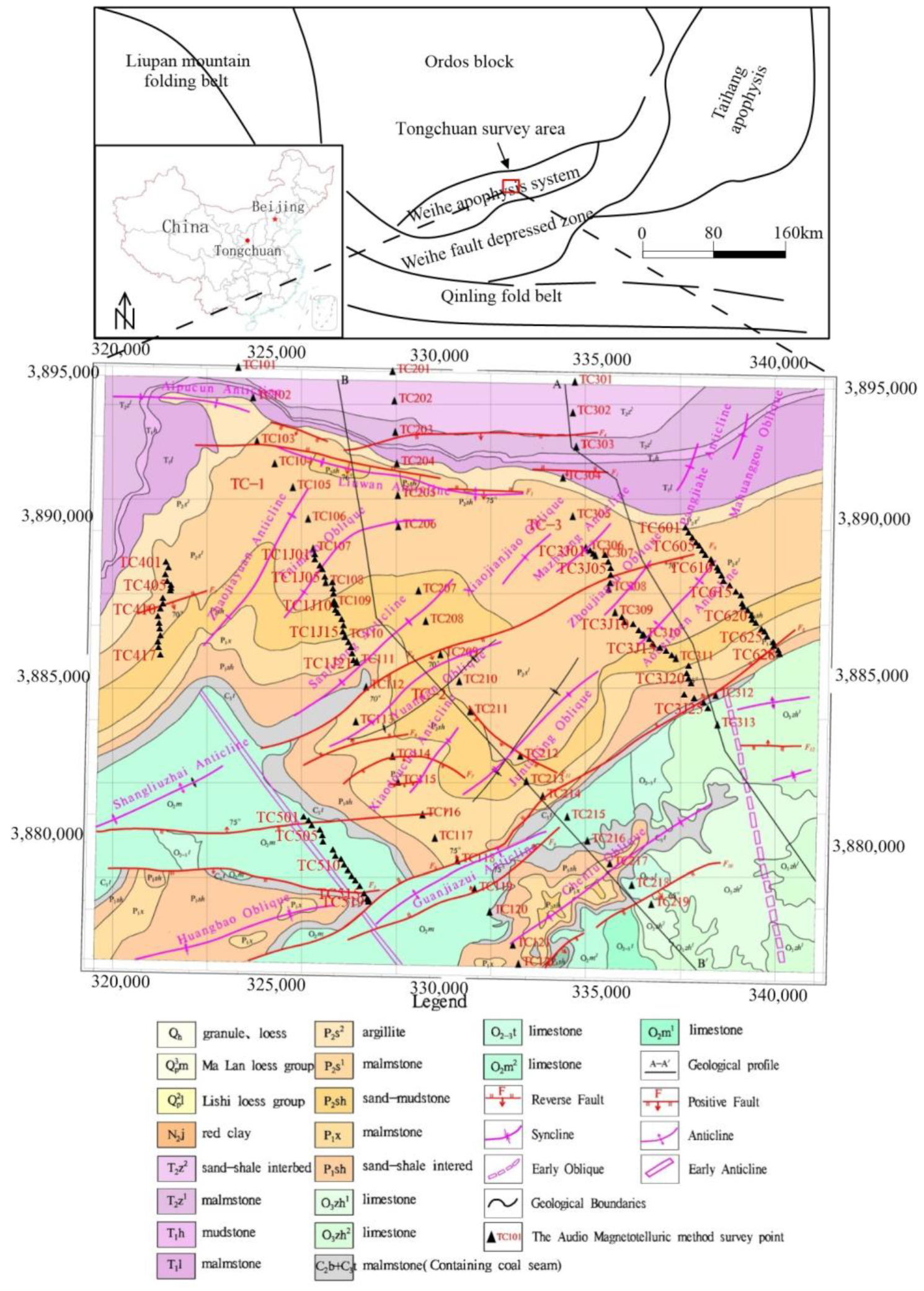
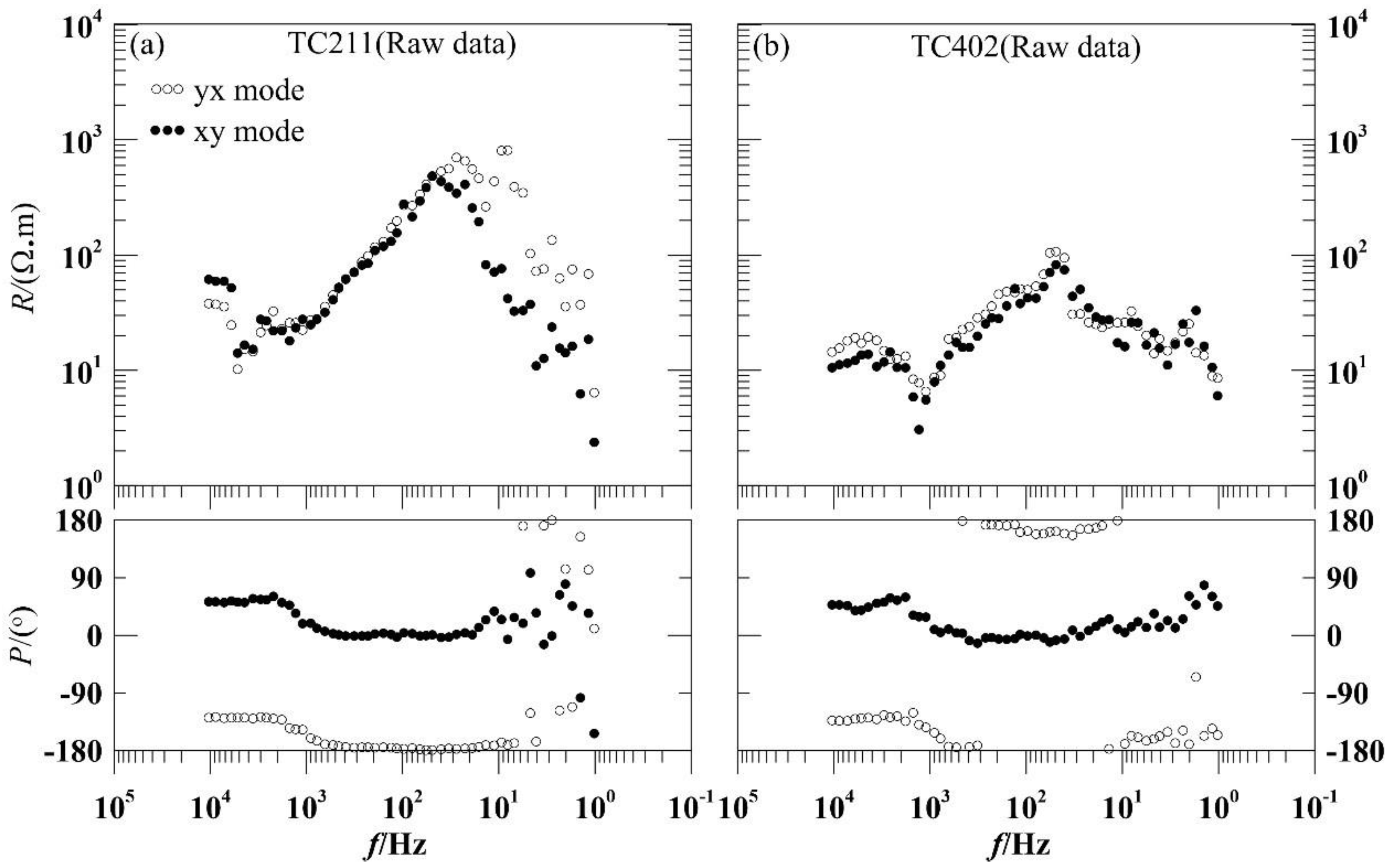
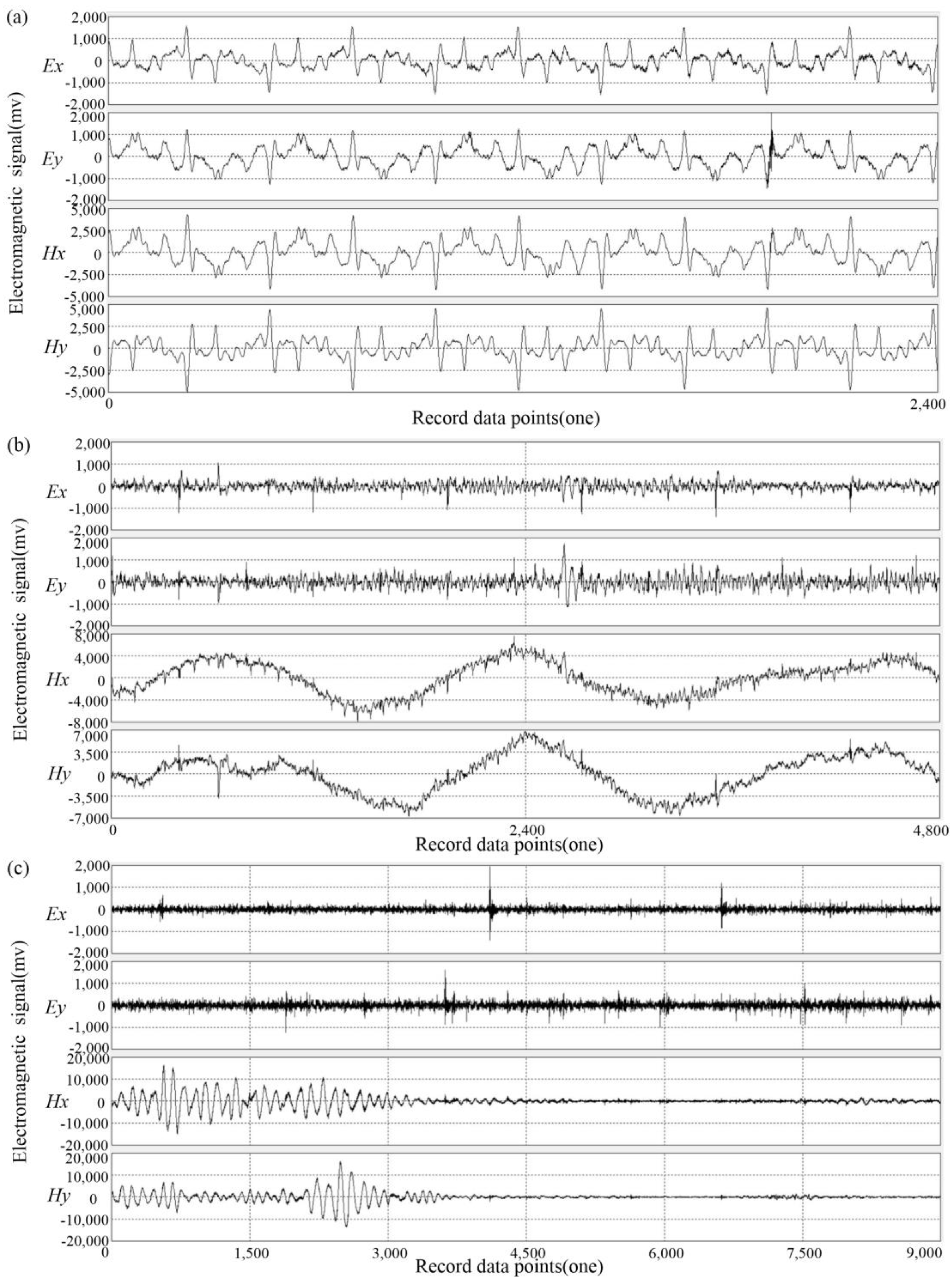
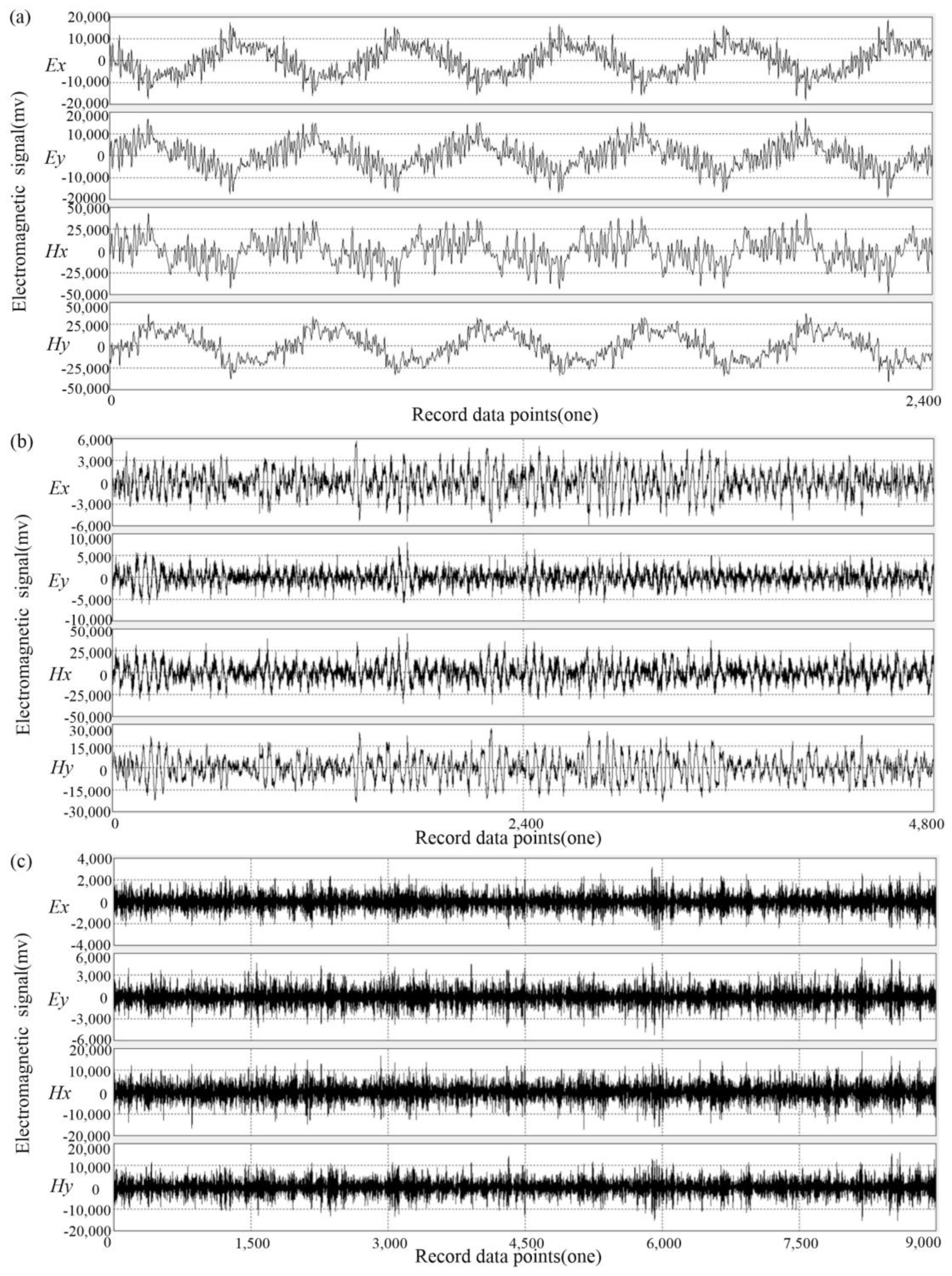
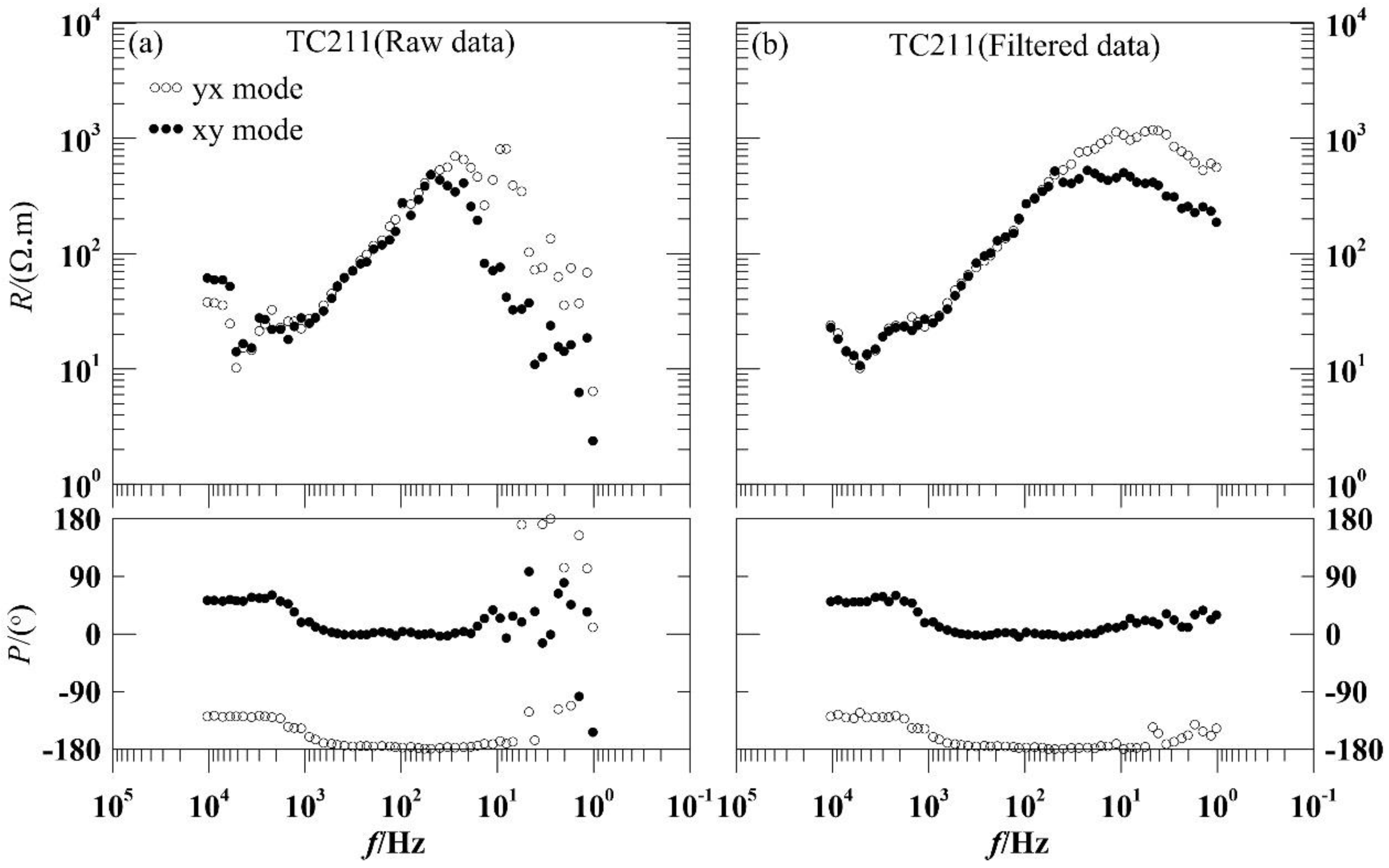
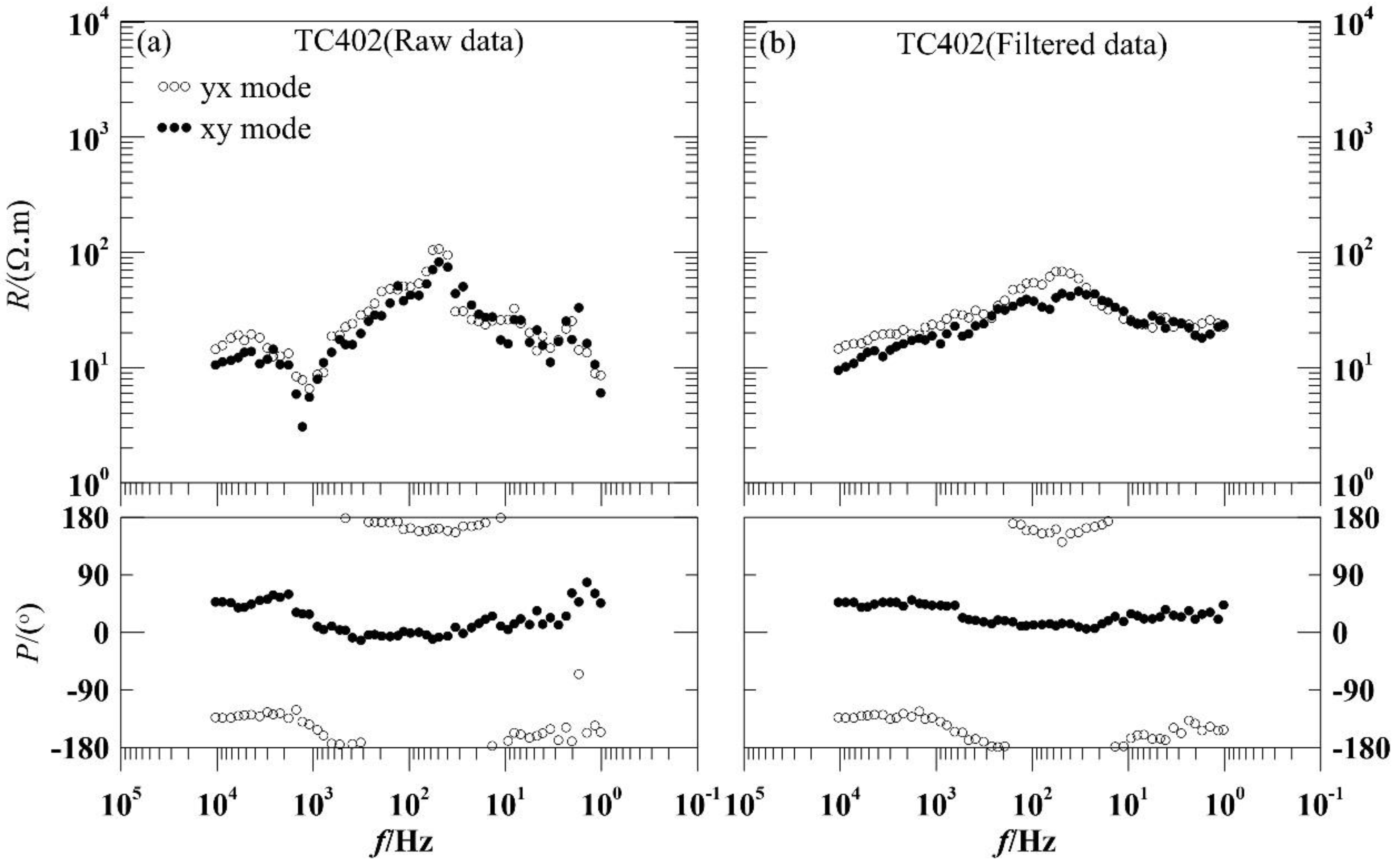
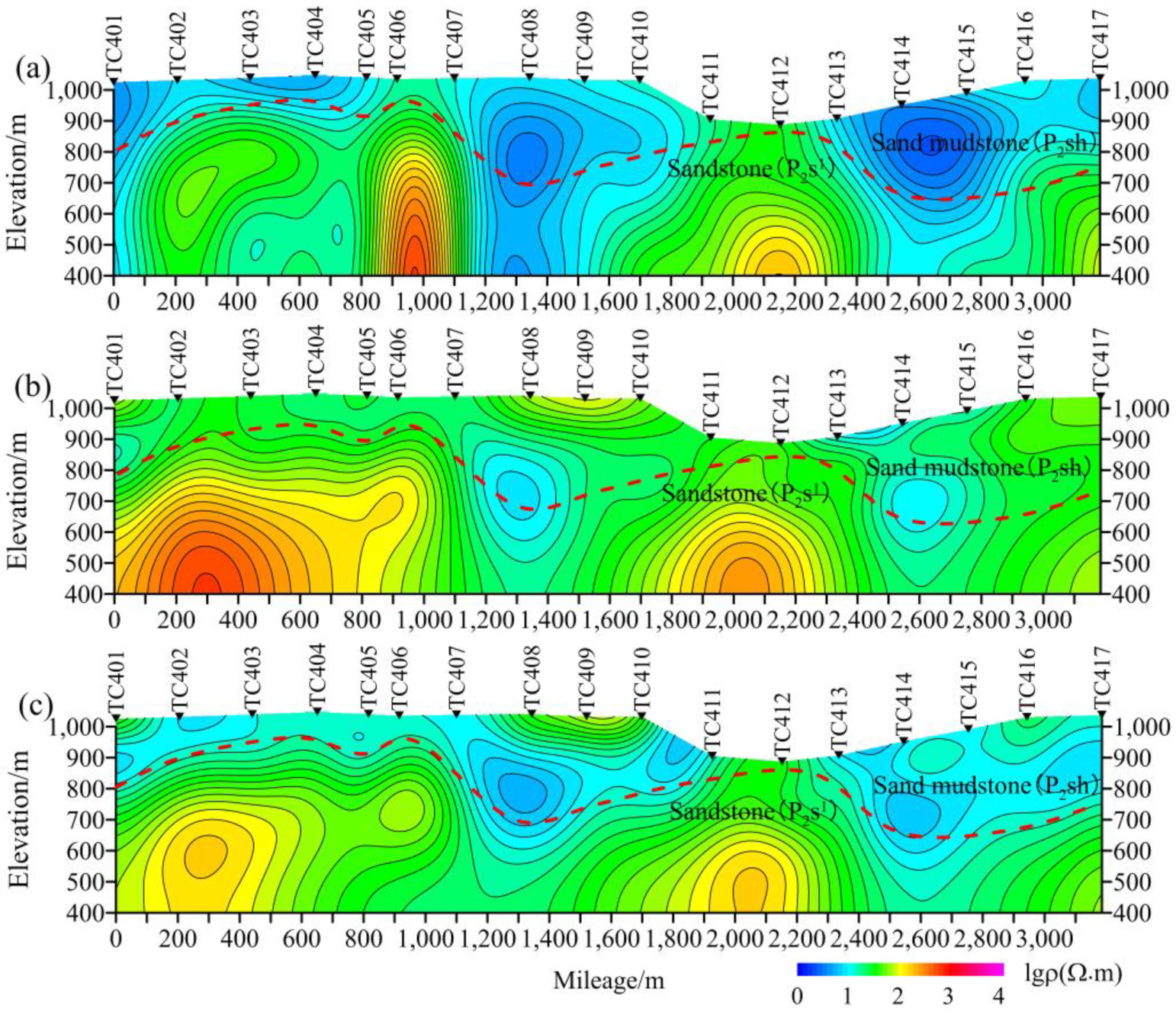
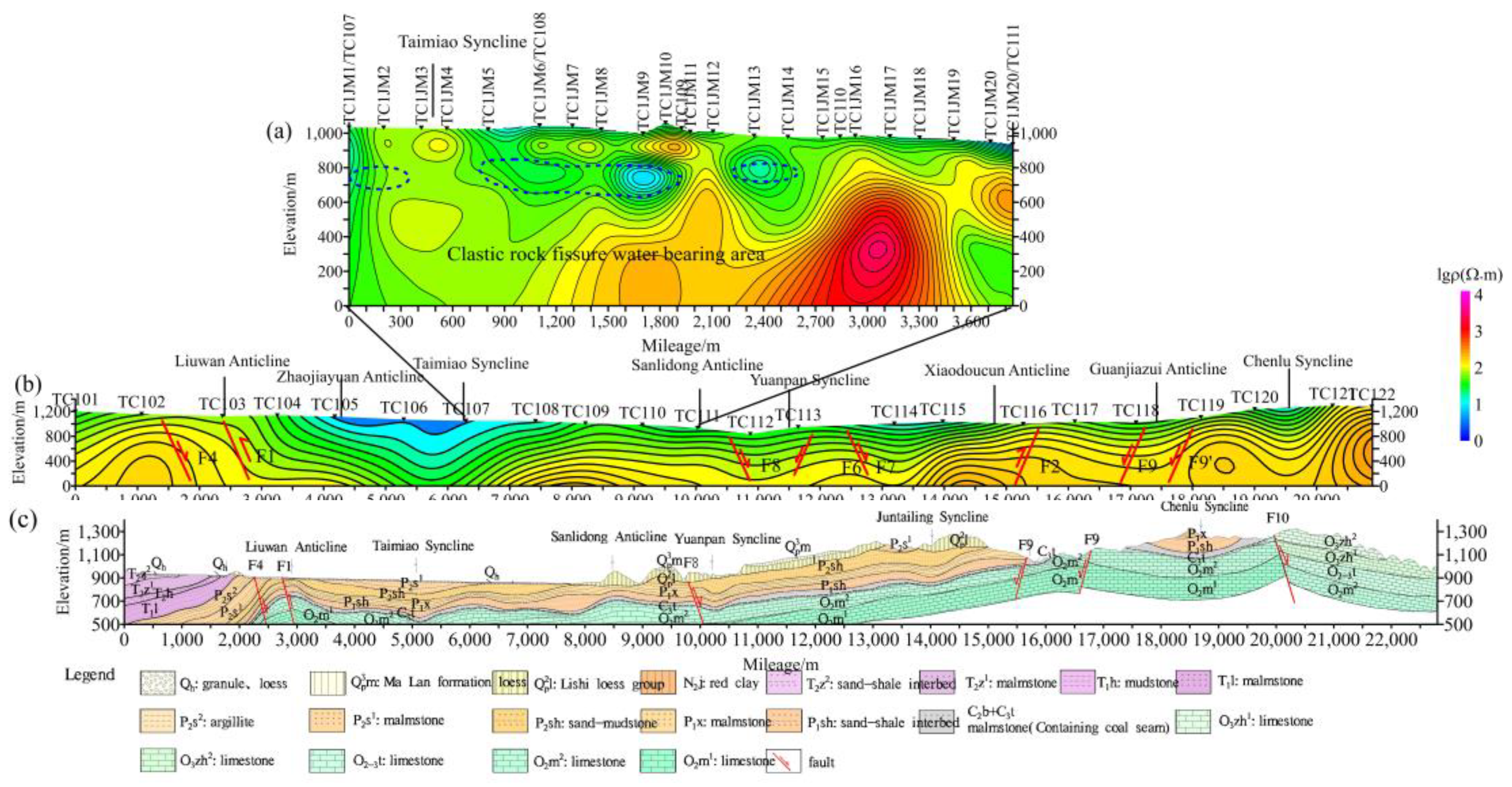
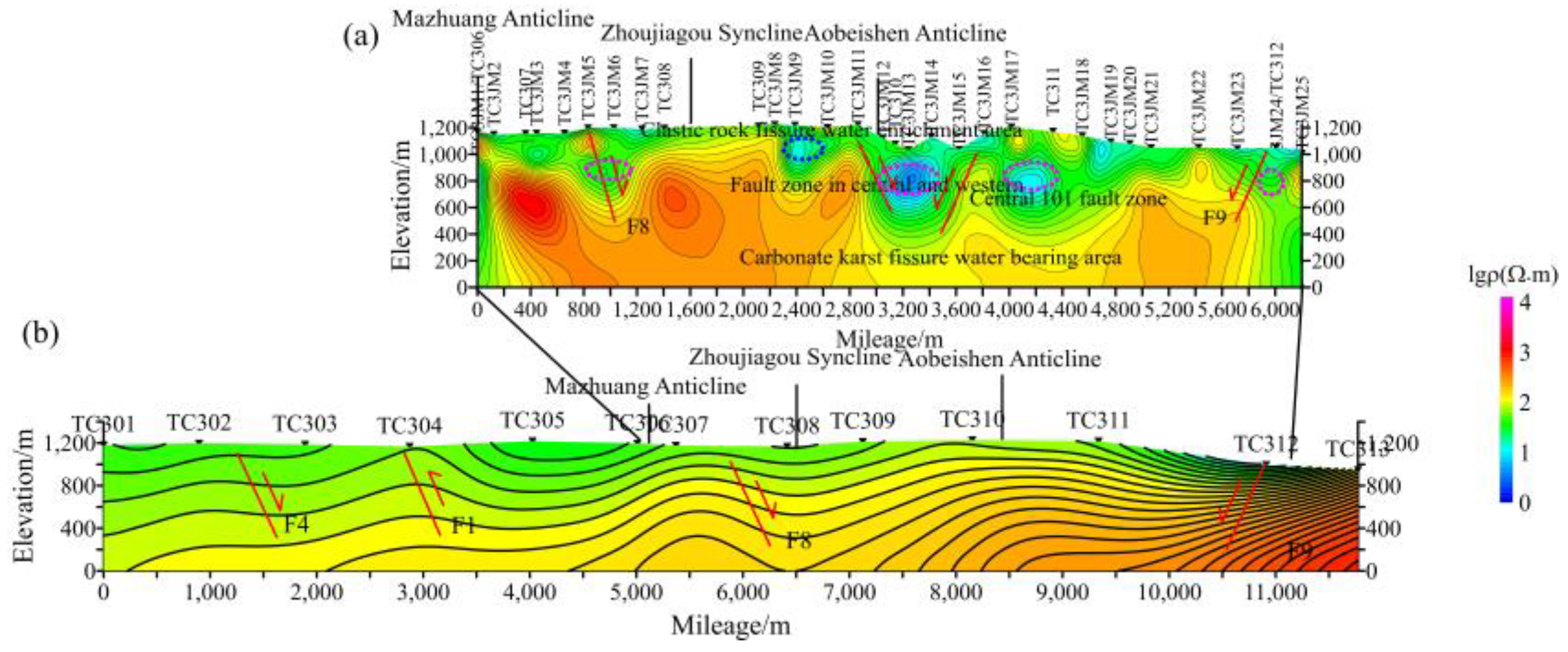









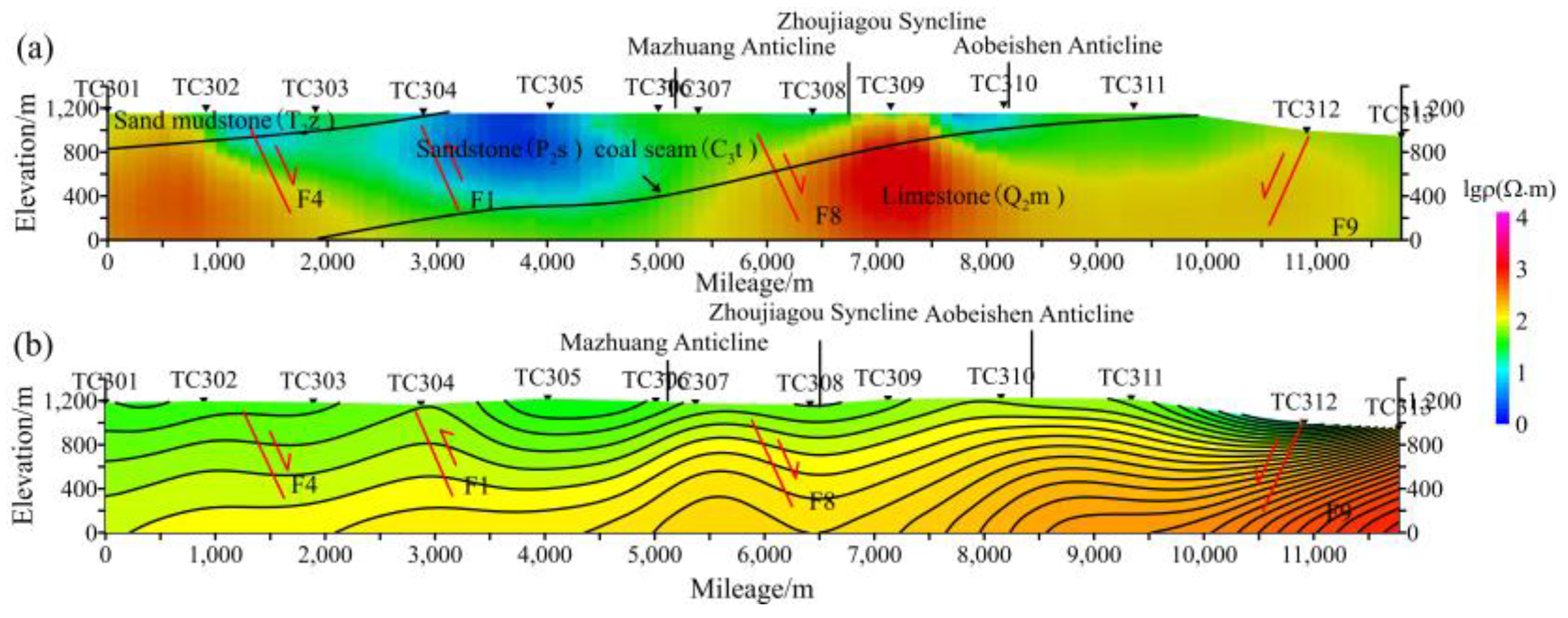

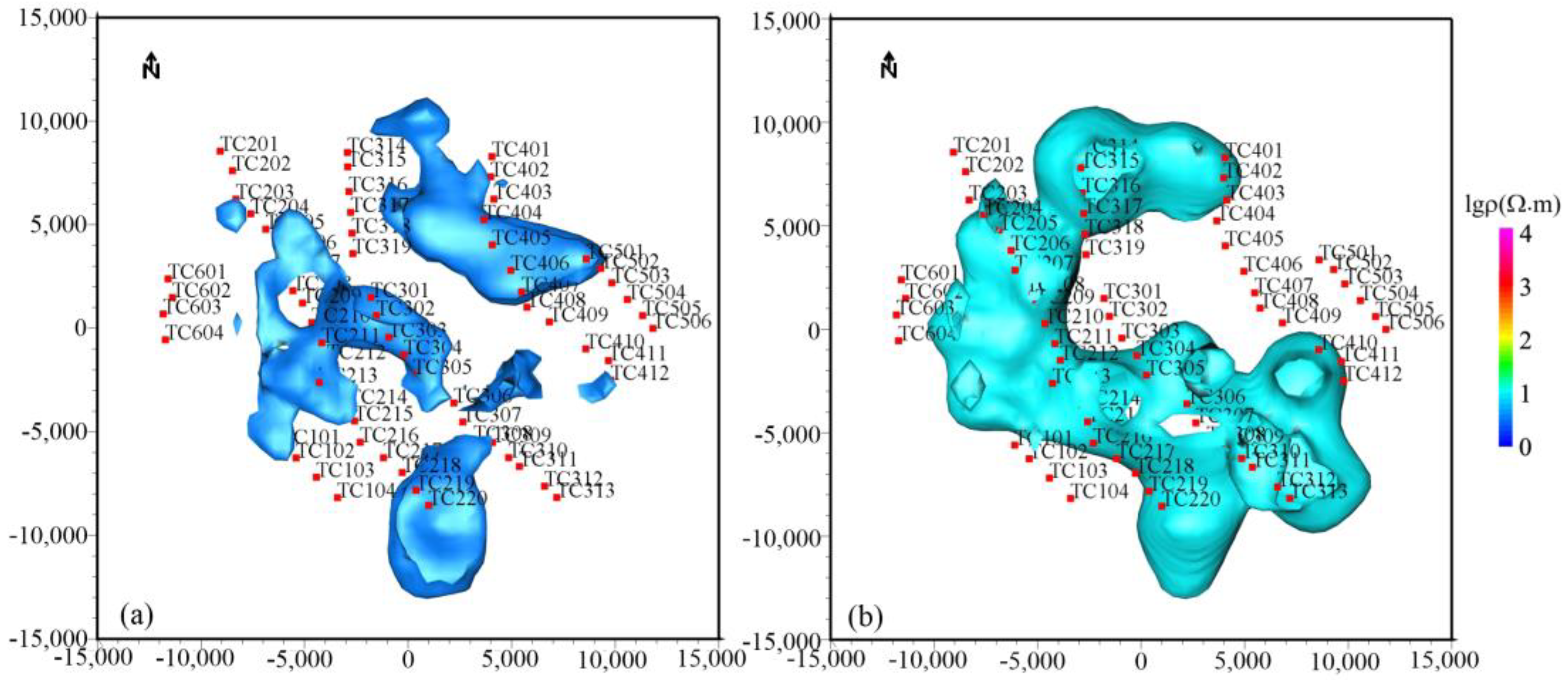
| Code | Nature | Occurrence | Description |
|---|---|---|---|
| F1 | Reverse fault | Dipping 70° S | Located in the Yangwan–Zaomiao area, and composed of a series of nearly parallel reverse faults, forming an east–westward compression belt together with the Aibo- Liuwan anticline and syncline. |
| F2 | Reverse fault | Dipping 75° N | Located in the area of Langwoli–Xiabian Village, and developed in the limestone of the Majiagou Formation. Extends eastward, and becomes elusive at Sikuanggou due to coverage. |
| F3 | Normal fault | Dipping S | Located in the area of Qijiashan–Dujiayuan–Xiabian Village, 1.5 km south of the Langwoli–Xiabian Village fault, and merged with the Shijiayuan–Renjiawan fault at Luozhai Village. |
| F4 | Normal fault | Dipping 70° S | Starting from Yangwan in the west, passing through the south bank of Wujiahe River, and ending at the north of Nanguzhai in the east. It is a concealed fault covered by loess. |
| F5 | Reverse fault | Dipping 70° S | Located in the northwest of the Zhaojiayuan anticline. It is a concealed fault covered by loess. |
| F6 | Normal fault | Dipping 55° N | Distributed in the west of Baozibei, extending 2500 m. It is a tensile fault. |
| F7 | Normal fault | Dipping 48° S | Distributed in the east of north Gaojiayuan, extending 2.8 km. It is a tensile fault. |
| F8 | Normal fault | Dipping 75° NE | Distributed in the south of Shijiahe River, as the northern boundary of Taoyuan Mine. The hanging wall is the Shanxi formation and Taiyuan formation, and the footwall is the Shangshihezi formation. It is a tensile fault. |
| F9 | Normal fault | Dipping 75° N | Located in the south of the Huangpu syncline. Starting from Renjiawan in the east and passing Guanjiazui in the south, the fault is composed of two parallel normal faults, and mainly developed in the limestone of the Majiagou formation. |
| F10 | Normal fault | Dipping 65° S | Located in the Liushuwan–Jiaziwo area and composed of two discontinuous faults, the fault has destroyed the upper and lower subtectonic layers. |
| F11 | Normal fault | Dipping 60° SW | Distributed in the area of Dianzipo and Juntailing, extending 3 km. |
| F12 | Reverse fault | Dipping 70° N | Located in the Yujiahe and Huangjiayao areas, east of Wangshiao. The fault is developed in the limestone of the Zhaolaoyu formation and forms a compression fracture zone of nearly 100 m together with east–west folds. |
| Stratum | Stratum Code | Lithology | Apparent Resistivity Range (Ω.m) | Apparent Resistivity (Ω.m) |
|---|---|---|---|---|
| Quaternary | Q | Loess | 10~50 | 35 |
| Cretaceous | K | Conglomerate, sandstone, siltstone, mudstone | 60~200 | 120 |
| Jurassic | J | Conglomerate, sandstone with mudstone and coal seam | 120~400 | 250 |
| Triassic | T | Sandstone and mudstone | 200~700 | 360 |
| Permian | P | Sandstone and sandy mudstone | 240~850 | 450 |
| Carboniferous | C | Sandstone and mudstone | 300~900 | 600 |
| Ordovician | O | Limestone and dolomite | 500~3000 | 2000 |
Disclaimer/Publisher’s Note: The statements, opinions and data contained in all publications are solely those of the individual author(s) and contributor(s) and not of MDPI and/or the editor(s). MDPI and/or the editor(s) disclaim responsibility for any injury to people or property resulting from any ideas, methods, instructions or products referred to in the content. |
© 2023 by the authors. Licensee MDPI, Basel, Switzerland. This article is an open access article distributed under the terms and conditions of the Creative Commons Attribution (CC BY) license (https://creativecommons.org/licenses/by/4.0/).
Share and Cite
Xu, Z.; Xin, H.; Weng, Y.; Li, G. Hydrogeological Study in Tongchuan City Using the Audio-Frequency Magnetotelluric Method. Magnetochemistry 2023, 9, 32. https://doi.org/10.3390/magnetochemistry9010032
Xu Z, Xin H, Weng Y, Li G. Hydrogeological Study in Tongchuan City Using the Audio-Frequency Magnetotelluric Method. Magnetochemistry. 2023; 9(1):32. https://doi.org/10.3390/magnetochemistry9010032
Chicago/Turabian StyleXu, Zhimin, Huicui Xin, Yuren Weng, and Guang Li. 2023. "Hydrogeological Study in Tongchuan City Using the Audio-Frequency Magnetotelluric Method" Magnetochemistry 9, no. 1: 32. https://doi.org/10.3390/magnetochemistry9010032
APA StyleXu, Z., Xin, H., Weng, Y., & Li, G. (2023). Hydrogeological Study in Tongchuan City Using the Audio-Frequency Magnetotelluric Method. Magnetochemistry, 9(1), 32. https://doi.org/10.3390/magnetochemistry9010032








